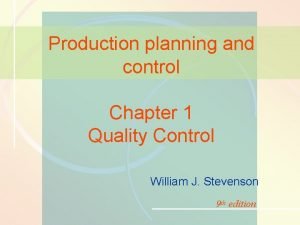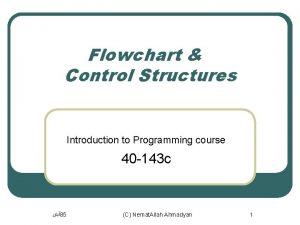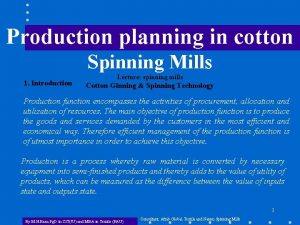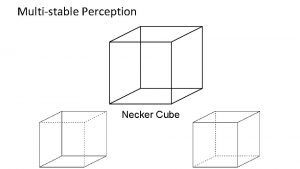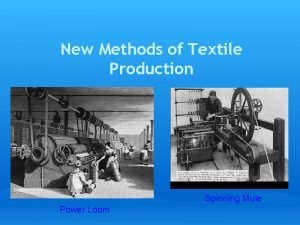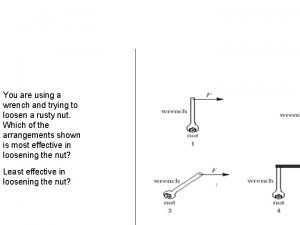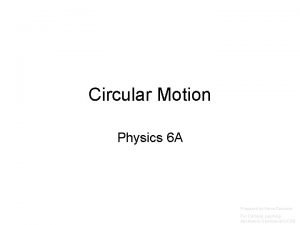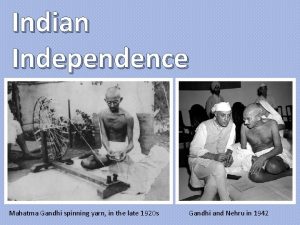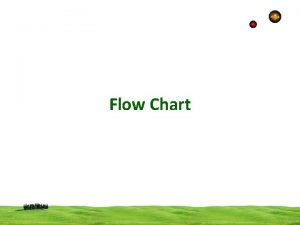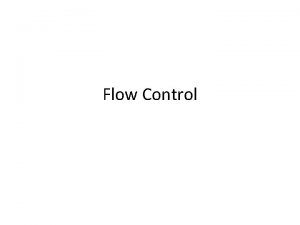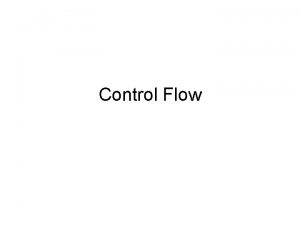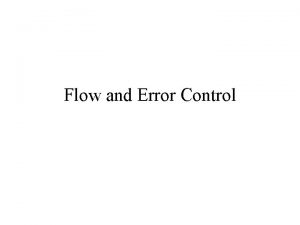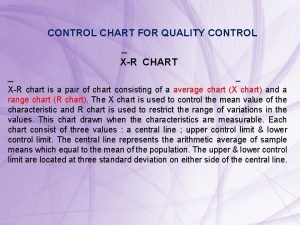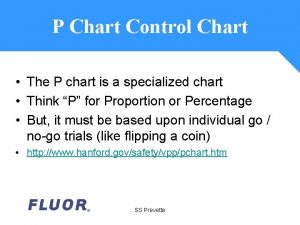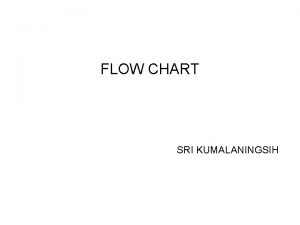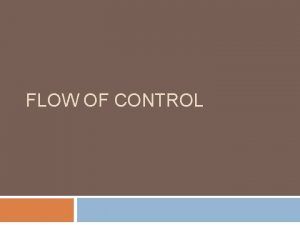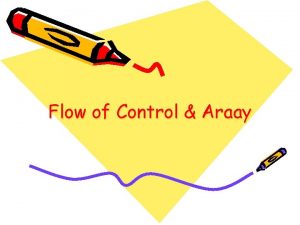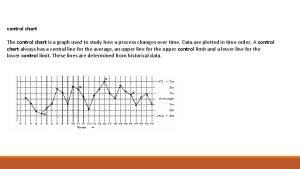Quality Control in Spinning 1 Flow Chart of






































- Slides: 38

Quality Control in Spinning 1

Flow Chart of Spinning

Quality of product in spinning can be improved either in back section (Blow room, carding and drawing) or in spinning section (Simplex and Ring frame). In back section we can control • Presence of trash in the materials • Neps percentage in materials • Uniformity of materials

Quality of product in spinning In spinning section, the following quality can be control • • • Count variation TPI variation Strength Hariness Imperfection etc

Importance of different parameters in quality of yarn Yarn Quality Fibre Properties Processing

Critical difference(CD): • Critical difference is a measure of the difference between two values that occur due to normal or unavoidable causes. When the difference between two values exceed that of the critical difference, the two values are said to be statically different. • Critical differences depends on: i) CV% ii) No of test. 6

Calculation of CD% • CD%(New)=CD% (table)√(N 1/N 2) Here, N 1=Number of test recommended in the table N 2= Number of test actually conducted Table-1: No. of test and critical difference (%) for various fibre properties: Fibre Property No. of tests CD(%) 2. 5% span length 4 combs/sample 4 Uniformity ratio 4 combs/sample 5 Microniare value 4 plugs/sample 6 Fibre strength 10 breaks/sample 5 Trash content 8 test/sample 7 7

Calculation of CD% Table-2: No. of test and critical difference (%) for various yarn properties: Yarn Property No. of tests CD(%) Lea count 40 2 Strength 40 4 Single yarn strength 100 2. 8 Evenness 5 2. 8 8

Problem • Problem-1 A mill wanted to purchase a cotton of 3. 7 microns value to spin 50 s count. The sample cotton received from a party was tested for micronaire and it was found to be 3. 9 ( on the basis of 4 test). The mill is interested to know that whether the sample cotton conforms the mills requirements. • Problem-2. Mill C received 5 cotton samples from A & B. Their strength value were found to be 22 g/tex and 24 g/tex respectively (based on 5 tests). Which decision was taken by the mill? • Problem-3. Mill Z received yarn sample from gulshan spinning mill and karim spinning mill. Their strength was found 20 g/tex and 22 g/tex (Based on five tests). Which dicision will be taken by the mill? 9

Solution of Problem 1

Solution of Problem 2

Uniformity ratio • Staple length: Staple length is defined as the length of a typical portion of sample of fibres i. e. full length or end to end length. • Span length: Span length is defined as the distance exceeded by a specific% of fibres extending from a random catch point. • 2. 5% Span length: 2. 5% span length is defined as the distance of 2. 5% of the fibres extended from the clamp where they are caught at random along their length. • 50% Span length: 50% span length is defined as the distance of 50% of the fibres extended from the clamp where they are caught at random along their length. 12

2. 5% & 50% span length

2. 5% & 50 % Span length

Uniformity ratio • Uniformity ratio: Uniformity ratio is defined as the ratio of 50% span length to the 2. 5% span length expressed as a percentage. The uniformity ratio is a measure of the length variability of cotton fibre. If the uniformity ratio increases then the variability will be decreased. 15

Yarn Fault The undesirable and sometimes unavoidable defects that are found in yarn are known as yarn fault. It is impossible to produce fault-free yarn. So the spinners try to produce yarn with considerable limit of fault. Faults found in yarn are: • Count variation • Unevenness & irregularity • Frequently occurring fault • Seldom occurring fault • Hairiness • Lot mixing 16

Types of Yarn Fault • Count variation: According to the textile institute, “ Count is the mathematical expression of fineness which expresses the length per unit weight of weight per unit length”. Practically ± 0. 3 Ne count variation is acceptable. Count can be measured by wrap reel and balance or using count measuring software (CMS). • Unevenness or irregularity: It is the mass variation per unit length. Cut length is taken generally 1 cm. This fault is expressed as U% or CV%. Evenness tester is used to measure unevenness. 17

Types of Yarn Fault • Frequently occurring fault: These faults occur in yarn 10 -5000 times per 1000 m of yarn. Yarn spun from staple fibres contains ‘imperfection’ which can be subdivided into three groups. These three faults are normally measured in no. of faults per 1 km. These types of faults are determined during evenness testing with imperfection indicator. Imperfection X-sectional size Fault length Thin place D-(30 to 60)% of D 4 to 25 mm Thick place D+(35 to 100)% of D 4 to 25 mm Neps D+(40 to 400)% of D 1 mm Here, D= Dia of normal yarn 18

Frequent occurring yarn faults

Types of Yarn Fault • Seldom occurring fault: These faults are referred as yarn fault and characterized in the form of thick and thin places in the yarn which are so seldom-occurring that for their determination at least 1000 km of yarn must be tested. Fault Name Thickness Fault length Short Thick place Above +100% of D Approx. 0 -8 cm Long Thick place Above +45% of D More than 8 cm Long Thin place Above -30% of D More than 8 cm Here, D= Dia of normal yarn 20

Types of Yarn Fault • Hairiness: Hairiness means the protruding fibres on yarn surface. It is the ratio of the total length of hair in any unit to the length observed in same unit. Generally it is measured as the ratio of total length of protruding fibres (in cm) per cm of yarn. The hairiness value is the ratio of two lengths; so it has no unit. • Lot mixing: Sometimes two lots can be mixed at the stage of sliver, roving, bobbin, cone and cartoon in spinning mill, as well as in the preparatory section weaving and knitting mill. This type of mixing causes several problems in subsequent process. 21

Yarn classimat faults

Objectionable yarn faults and Practical examples yarn faults

Yarn standards

Causes of imperfection • Causes of thick & thin places: 1. Short fibre content 2. Improper draft 3. Poor efficiency of carding & combing 4. Twist variation • Causes of Neps: • Immature fibre • Improper ginning • Improper carding speed & card setting • Less efficiency of card • Improper drafting speed 25

Factors Affecting Yarn Strength 1) Quality of Mixing: • Fibre Properties: Better length, strength & fineness of fibre gives better yarn strength. • Mixing Ratio: Proper mixing leads to higher & uniform yarn strength. 2) Quality of carding: • Mechanical condition of all carding surface • Waste control in carding action • Proper maintenance 26

Factors Affecting Yarn Strength 3) Quality of comber: • • Level of comber waste. Mechanical condition of comber. 4) Quality of drafting at ring frame: • • Mechanical condition of the drafting system. Total draft. Break draft. Types of drafting system 27

Factors Affecting Yarn Strength 5) Quality of twisting at ring frame: • Amount of appropriate twist. • Level of twist • Uniformity of twist 6) Other processing factor: • Atmospheric condition • Static electricity • Direction of feeding of fibre hooks. 28

Fibre testing equipments • HVI: For fineness, color, trash, length & strength measurement. • AFIS: For neps, size of neps, fibre length, short fibre content, fineness, immature fibre content, no. and size of trash measurement. • Shirley Analyser: For trash content measurement. • Nep counter: For fibre length, neps, short fibre measurement. • Moisture Regain tester: For MR% testing. 29

Lap, Sliver & Roving testing equipments • Lap length counter • Balance, Scale, Wrap block: For testing sliver & roving testing. • Nep counting board • Auto sorter: For sliver count testing. • Evenness tester. 30

Yarn testing equipments • • Wrap reel and balance: Yarn count testing Auto sorter: For count & CV% analysis Evenness tester: yarn imperfection, U%, hairiness etc. Uster classimate: Yarn fault analysis. Yarn tension meter Twist tester Yarn strength tester Software: • BIAS: For bale management • CDS: For Automatic count measuring 31




Solution of Problem 1



 Flow chart of spinning process
Flow chart of spinning process Www.mbaknol.com
Www.mbaknol.com Perform quality assurance
Perform quality assurance Project quality management pmp
Project quality management pmp Pmp gold plating
Pmp gold plating Basic concepts of quality
Basic concepts of quality Data flow vs control flow
Data flow vs control flow Control flow and data flow computers
Control flow and data flow computers Control flow vs transaction flow
Control flow vs transaction flow Cheddar cheese production flow chart
Cheddar cheese production flow chart Quality control chart
Quality control chart Stock control e flow control
Stock control e flow control Flow control and error control
Flow control and error control Language
Language Control structure flow chart
Control structure flow chart Spin plan
Spin plan Spinning dancer
Spinning dancer 1940 spinning top
1940 spinning top A pole vaulter first converts kinetic energy into
A pole vaulter first converts kinetic energy into Spinning jenny konsekvenser
Spinning jenny konsekvenser A movement that stays on one spot is axial movement
A movement that stays on one spot is axial movement Spinning mule
Spinning mule Spinning mule impact
Spinning mule impact Salvino darmate
Salvino darmate A ladybug is clinging to the rim of a spinning wheel
A ladybug is clinging to the rim of a spinning wheel Leukocyte esterase
Leukocyte esterase Advantages of friction
Advantages of friction Philadelphia textile
Philadelphia textile The spinning wheel of doom
The spinning wheel of doom Melt spinning
Melt spinning Gandhi spinning yarn
Gandhi spinning yarn Spinning jenny
Spinning jenny Spinning jenny
Spinning jenny A spinning figure skater pulls his arms in as he rotates
A spinning figure skater pulls his arms in as he rotates Spinning cylinder
Spinning cylinder Belankai
Belankai Hvorfor var spinning jenny viktig
Hvorfor var spinning jenny viktig Beinnings
Beinnings Ana model of quality assurance
Ana model of quality assurance










